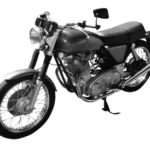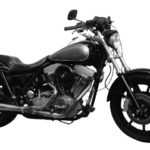It’s hard to know where to begin. This month my head wanted to do a little treatise on the life and hard times of the average piston ring. My heart said otherwise.
Let’s face it—as much as I’d like to be the dispassionate purveyor of tech trivia and mechanical maybes, I’m no different than most folks who get into this hobby insofar as it’s mostly about passion. Logic often has little to do with it. That’s as it should be… or should it?
See, after almost 50 years of dorkin’ with scooters, in the words of a U2 tune: “I still haven’t found what I’m lookin’ for.” This sucks on many levels. Intense exposure to serious study of the subject matter at hand simply leads to a state of mild mental paralysis—not a solution to the problem. What problem? Why, finding the perfect motorcycle… naturally! Forgive the self-indulgence, but I’ve just about gotta use my own case as the lab rat for this experiment in curing myself of the disease. Owning more motorcycles over time than I can recall and lusting after a butt-load more (that I know damn good and well I’ll never even get to ride, let alone possess) can make you a little crazy. Not an excuse—just fact. I bore most normal people in civilized conversation because I cannot help but interject a sort of philosophy of life—Zen and the Art of Motorcycle Magic—into every kind of topic. It’s a macro/micro curse of the intellect that comes from spending too much of your waking time thinking, breathing, eating, sleeping, living and loving these two-wheeled inanimate objects that most “sane” people only see as a shortcut to the ER or a tombstone. They not only don’t get it, but motorcycles aren’t even on their radar. And of course I’m the moron who actually does try to explain what they’ll never understand. (In short—no fun at cocktail parties.) So, for this kind of small talk about big things that only matter to the select few (us), I have to turn to you as my sounding board.
OK—so back to the perfect motorcycle.
I’ve decided that like the quest for the Holy Grail, some errant knights out there have learned (if only subliminally) that it’s really about the pursuit, not the object itself. There’s wisdom in that, unless you go overboard with it and it sinks you with payment books and insurance rates and other invisible baggage, which goes along with always having to have the latest and/or greatest. Incremental updating is an annual event that seemingly improves the breed to the point where you simply gotta have it every few years—whatever “it” is. (Obviously, for most readers of this column that means a Harley, but the quest applies to all brands and types of motorcycles.) For me, that takes the form of lusting after a Buell 1125R, even though there’s no friggin’ way I can do that bike justice at my age and in my condition. (Meaning, I can’t/won’t ever ride one to its limits and I’m too cheap to cough up the cash.) It’s moto-lust at it’s most infuriating and conflicting.
An offshoot of the quest is what I refer to as the “fly-in-amber brigade” who believe that a real motorcycle hasn’t been made since about 1969. These guys are all about obsolete—Triumphs, Vincents, Panheads and Nortons… (Ahem!) like my Commando. Most of these people have a point—a sharp one, actually. Classic bikes, after all, tend to go up in value, are simple to work on, easy(-ish) to find parts for, fun to ride and more often than not are, to some degree, rare. (For instance, even mass-produced bikes like my Norton numbered only 55,000 of the brand’s nine-year model life. Thirty years later, how many survive, do you think?) The other thing about old crocks and the men who love ’em is the notion that the characteristics and capabilities of both tend to match. In my case, 60-year-old reflexes, skills, abilities, attitudes (sense of self-preservation) and experience interface with my 400-lb, 55-hp Brit relic’s brakes, handling and acceleration, so we can both go well up to about 8/10ths. Beyond that, we both get a little over our heads—and know it full well. But the fact remains that I’m still able, at my age, to ride a machine of its age pretty much as hard as either of us can/should really go—just the opposite of the situation I envision with, say, an octogenarian on a Hayabusa!
The issue here is believing, as many fans of this particular quest do, that the way it was done then is the way it should be even now. I’ll tell ya right now, to ignore advances in brakes, ignitions, lubricants and filtration (to name but a few) in favor of bone-stock total originality in these old machines is foolish and dangerous—if they are to be ridden and not turned into museum pieces.
From quests to cults is a shorter hop than one might imagine. Cult bikes abound, believe it or not. Largely, this is because over the years literally everything that could be tried in two-wheeled design has been tried. The results may not be mainstream but trust me, they find fans all the same. Some of them were ahead of their time, like Vincent Rapides or Yamaha Visions. Some were time-warped into prominence today even though ordinary in their day, as is the case with Royal Enfield Bullets. Others were simply engineering cul-de-sacs through no particular fault of their own, such as two-stroke street bikes. (Legislation has often killed off promising engineering.) There are even a few examples of answers to questions that nobody asked—rotary-engine motorcycles being convenient yet obscure instances. Personal leanings in this direction lead directly to my 1975 T500 Suzuki. Philosophically, a twin-cylinder bullet-proof engine with only 14 moving parts and a precisely metered supply of constantly clean oil is very appealing. (Can’t help myself—it seems that simple and elegant are recurring themes of my eternal, infernal, internal esthetics… dang it!) Cult motorcycles are most likely to be possessed by (or possess) real fanatics. Ask anyone who’s ever had the good fortune to own one of Harley-Davidson’s own ventures into weird—like a 1922 Sport Twin or military XA from 20 years later, both with horizontally opposed cylinder layouts—one fore and aft with a chain and the other side to side with a shaft!
Whichever way we lean on the road to the perfect motorcycle, regardless of the depth and width of our quest, mainstream or cult, old or new—the end of that road can be a surprise. You might actually achieve perfection by design (or by accident)—via the means that Harley riders can take better advantage of than any other. You create it! This is a multi-layered approach to say the least. One extreme is the “checkbook custom” where Mr. Owner contributes little more than money and perhaps input ranging from an occasional suggestion to a complete vision of the finished product done by professionals. The other extreme is the DIY junkyard dawg spawned from lack of funds and desire for basic function… or any kind of function at all! Either extreme, or anywhere in between for that matter, starts out with the building blocks of factory creation(s), but from there the quest for personalized perfection results in anything from junk to jewel—but one of a kind all the same! My 1985 FXRP is probably typical. A workhorse motorcycle, it started life with saddlebags, floorboards, a bulbous proboscis of a fairing and a job to do. Today it has none of that, about twice the power, and about all that remains of the original rig is the tranny, frame, gauges, bottom end and wheels. It all happened (and is still happening) over decades of time and the result is my favorite motorcycle of all time… and all about fun. Yet, as much as it suits me, it’s hardly anyone else’s definition of perfection. There’s an insight in that fact –maybe a couple. Seems that the physical hardware and the mental software involved in a successful symbiosis between man and machine is a lesson in metaphysics. The reality of relationship lies not in one or the other—but what happens between the two.
“Best of British” is kinda like saying a mild case of measles, but if you’re infected (like I am), this is the least painful, at least. Norton Commandos are a curious mix of traditional and innovative. Light, fast and—yes—smooth above 2,500 rpm, due to clever isolation of vibration, years before Harley tried the same thing. They still handle and stop well enough to use on modern-day freeways (or canyon roads, for that matter). Yet, they archaically shift up for low and down for go on the wrong (right) side, and like most Big Twin Harleys, they keep engine and transmission separate. It doesn’t hurt that they are among the most beautiful motorcycles ever built. (You’ll put up with a lot for a pretty face.) Some folks like old Beemers, Italian icons like Laverdas, antique Hondas, or pre-Evo Hogs—but the simple fact is the British parallel twins were kings of the world (if not America) for decades. A good old Commando can show you why, better than the new Triumph Bonneville.
They definitely don’t make ’em like this T500 anymore! To me, that’s a pity, cause there’s plenty to keep you hooked on machines as arcane and delightfully unsophisticated as this one. For all intents and purposes, it’s like a two-stroke Harley. The difference is, you don’t buy bikes like this to impress your friends; just yourself. If it were an article of clothing, a Suzuki Titan would be faded blue jeans—pure and simple—and just as durable. (There’s no link between this old smoker and the RF, either! Other than the name on the tank, any resemblance is purely coincidental and/or accidental… whichever.) Two-stroke Suzi’s were really special and the new ones are just UJMs like the rest.
Far from perfect and yet the very embodiment of a keeper, the Harley-Davidson FXR series was/is arguably the best overall platform the motor company ever made. Any other motorcycles I own in addition to—but never instead of—the FXR. There have been flirtations with tons of German, Italian, Japanese and even other domestic motorcycles, but none have kept me coming back to the trough as much as this hog. I guess that means whether by luck or design, via quests logical or insane, and in spite of—not because of, this machine is the perfect motorcycle for me—until something better comes along. (Doesn’t it?) Anyway, whatever your proclivity or desire I only hope that someday you, too, will find one that ends your quest and makes you perfectly happy, and perhaps even sends you to Hog Heaven.
I seem to have a knack for acquiring undiscovered gems. An RF900 Suzuki isn’t a sport bike, or cruiser or tourer, but as an all-around ride is comparable to Honda’s highly regarded VFR series… with a bunch more power! Better than I deserve, but more boring than I can describe, like many an Asian creation—too good to be great… no matter how perfect. (This is a paradox that leads many an otherwise sane motorcyclist to Ducati, BMW or Harley dealerships, if they worship at the altar of function, yet need a little more food for the soul.)
Perfection is not an objective, but an obstacle.
This is why as often as we pay homage to the idea of “perfect” defined as flawless, the machines that usually get under our skin are the ones that are anything but flawless—in fact, so imperfect, they are almost human. You like a given motorcycle because of what it is—you love it in spite of what it is… y’know? It often begins with a determination as to whether you are attracted to a particular machine as it is, or because you see the potential in it. If the aggregate of attributes outweighs any niggles of imperfection—it’s on! My “modern” bike, a 1994 Suzuki RF900R falls into the former category. There’s a lot I don’t love about this soulless monument to efficiency, but I sure like the fact that of my entire fleet of two-wheelers, it’s the one I know would get me from LA to Denver (or anywhere else) with the least hassle in the least amount of time. It also holds the distinction of being the only motorcycle I’ve ever owned that I had no desire (or need) to modify. It works better than good—as is! The flipside is the unending list of flaws in the rest of my stable. Nobody owns a Commando because they believe Lucas had a handle on wiring, switches or anything else electrical, let alone oil-leak potential. The T500 is no paragon of handling with its water-pipe frame, drum brakes, crap shocks and pogo-stick forks. The FXR is too heavy by 100 pounds, a handful on switchbacks, has a face only a mother could love, ain’t cheap to keep and in the end—ah—isn’t a bagger. All this criticism even after all the time, money and mods!
I guess it doesn’t matter, because in the end, virtually in reverse order of my gripes, the bikes that would be banned from my garage would start with the Sensationally Sensible Suzuki 900 and halt abruptly before the Friggin’ Foolish FXR had to go. So, now that we’ve had our little chat and you know where I (shakily) stand, where (and how) would you draw the line at motorcycle perfection?
























